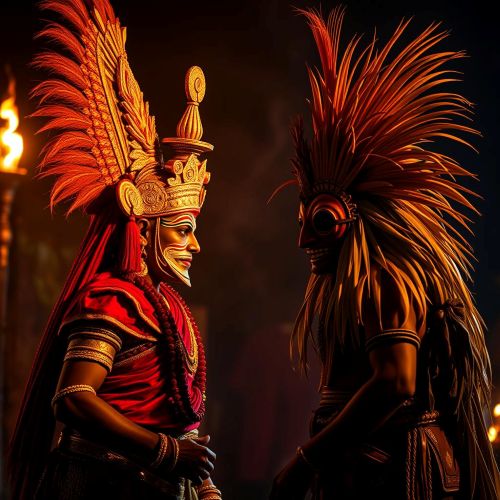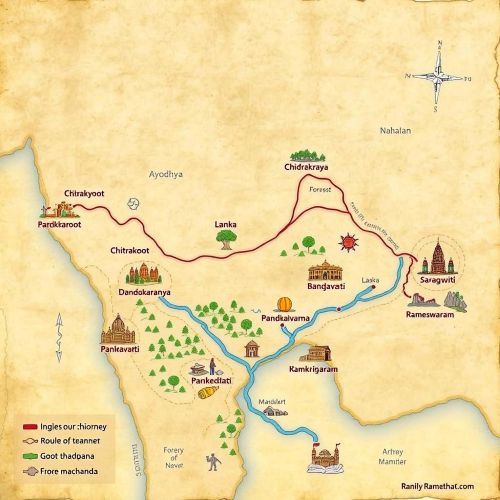Navaratri Across India: Regional Traditions and Rituals
Navaratri, meaning “nine nights,” is one of the most celebrated festivals in India, dedicated to the Goddess Durga and her many forms. While the central theme remains the triumph of good over evil, Navaratri unfolds differently across India, shaped by mythology, local customs, and cultural expressions. From Bengal’s grand Durga Puja to Gujarat’s Garba nights and Tamil Nadu’s Golu displays, each region ties its traditions back to myths, creating a vibrant mosaic of devotion.
The Mythological Core of Navaratri
At the heart of Navaratri lies the myth of Goddess Durga’s battle against Mahishasura, the buffalo demon who threatened cosmic order. The gods, unable to defeat him, combined their powers to create Durga, who waged war for nine nights before finally slaying him on the tenth. This story, known as Mahishasura Mardini, remains the foundation of Navaratri celebrations.
Yet, the myth takes on different forms across India. In the North, Navaratri also connects to Lord Rama’s victory over Ravana, symbolizing dharma’s triumph. In the South, the festival emphasizes the Goddess as a source of knowledge, prosperity, and cosmic harmony. Each variation reflects local mythology while celebrating the universal power of Shakti.
Bengal: Durga Puja and the Myth of Mahishasura
In West Bengal, Navaratri transforms into Durga Puja, the state’s biggest cultural and religious festival. Rooted in the legend of Mahishasura, Durga Puja showcases the Goddess as Mahishasura Mardini. Magnificent idols depict her with ten arms, each carrying divine weapons, as she slays the demon king.
The ritual goes beyond worship — pandals (themed pavilions) display mythological stories, while cultural performances retell episodes of Shakti’s might. In Bengal, mythology breathes through art, devotion, and community gatherings, making Durga Puja an embodiment of divine victory.
Gujarat: Garba and the Symbolism of Shakti
In Gujarat, Navaratri is synonymous with Garba and Dandiya Raas. The word Garba comes from Garbha Deep, a lamp placed inside a clay pot, representing the womb and divine energy. Devotees dance in circles around the lamp, symbolizing the eternal cycle of life powered by Shakti.
Mythologically, this practice honors the Goddess as the source of creation. The rhythmic dances are both celebration and spiritual offering, where each step reflects surrender to the Goddess. Gujarat’s Navaratri shows how mythology can transform into vibrant cultural expression.
North India: Ramlila and the Victory of Rama
In Uttar Pradesh, Delhi, and parts of North India, Navaratri culminates in Dussehra, which celebrates Lord Rama’s victory over Ravana. This tradition ties Navaratri to the Ramayana, where Rama seeks Durga’s blessings before his final battle.
The Ramlila performances, staged for nine nights, bring the mythological epic to life, with the burning of Ravana’s effigy on Dussehra symbolizing the triumph of good. Here, Navaratri fuses Goddess worship with Vaishnavite devotion, reflecting India’s layered mythology.
Tamil Nadu: Golu and the Divine Feminine
In Tamil Nadu, Navaratri is marked by Bommai Golu or the display of dolls on decorated steps. These dolls often depict mythological scenes, gods, goddesses, saints, and animals, symbolizing the cosmic order. The arrangement is more than decorative — it represents the Goddess restoring harmony to the universe.
The last three days are dedicated to Lakshmi, Saraswati, and Durga, showing the many aspects of Shakti. Saraswati Puja and Ayudha Puja, where tools, books, and instruments are worshipped, highlight mythology’s connection to knowledge and skill.
Karnataka: Mysuru Dasara and Chamundeshwari
Karnataka’s Mysuru Dasara is one of the grandest royal celebrations in India. Rooted in the local legend of Chamundeshwari, a fierce form of Durga, who killed Mahishasura atop Chamundi Hills, the festival blends mythology with royal traditions.
The myth is celebrated through elaborate processions, rituals at Chamundeshwari temple, and cultural events. The Mysuru Palace becomes the centerpiece, illuminated in devotion to the Goddess who embodies courage and justice.
Andhra Pradesh & Telangana: Bathukamma and the Floral Goddess
In Telangana and Andhra Pradesh, Navaratri is celebrated with Bathukamma, a festival of flowers dedicated to Goddess Gauri. Women gather to create colorful floral arrangements stacked like a temple tower, offering them in song and dance.
The mythology behind Bathukamma links it to the Goddess’ blessings for prosperity, fertility, and protection of life. The floral offerings symbolize nature’s abundance as an extension of divine power.
Kerala: Vidyarambham and the Goddess of Knowledge
Kerala emphasizes the worship of Saraswati during Navaratri. On Vidyarambham, children are initiated into learning by writing their first letters on sand or rice grains. This ritual is rooted in mythology, where Saraswati embodies knowledge and wisdom.
Navaratri in Kerala represents a balance between devotion and intellectual growth, showing how mythology extends into education and daily life.
Regional Unity in Diversity
From the fierce Mahishasura Mardini of Bengal to the floral Bathukamma of Telangana, Navaratri highlights the richness of Indian mythology expressed in diverse traditions. Each region preserves its unique myths while staying connected to the universal theme — the triumph of good over evil and the celebration of Shakti.
This unity in diversity makes Navaratri not just a festival, but a living example of how mythology adapts, thrives, and continues to inspire devotion across centuries.
Conclusion
Navaratri’s power lies in its ability to weave mythology into daily life, creating celebrations that are deeply regional yet universally spiritual. The stories of Durga, Rama, Chamundeshwari, and Saraswati are more than ancient legends — they shape the way millions worship, dance, and celebrate every year. Through its myths and rituals, Navaratri reminds us that the Goddess lives not only in temples but in the hearts and traditions of people across India.
No posts were found.









